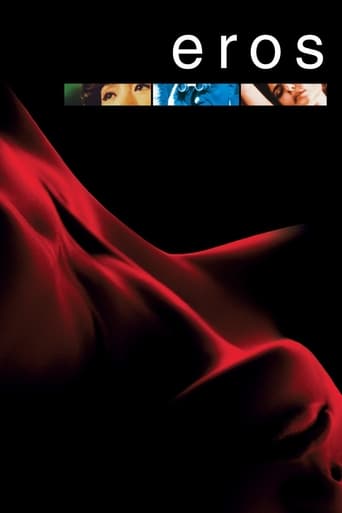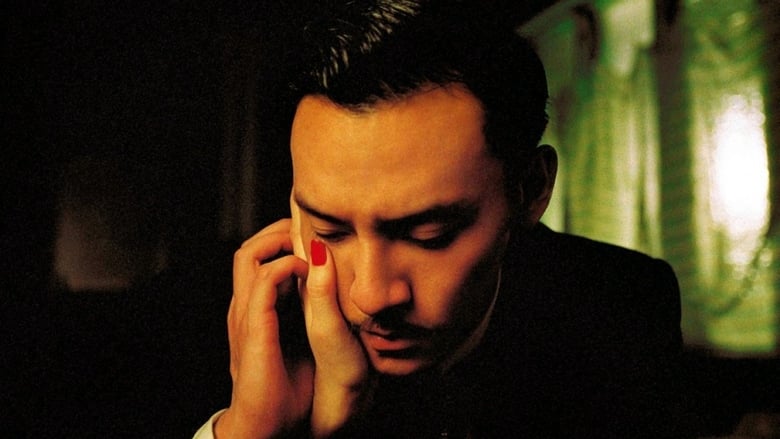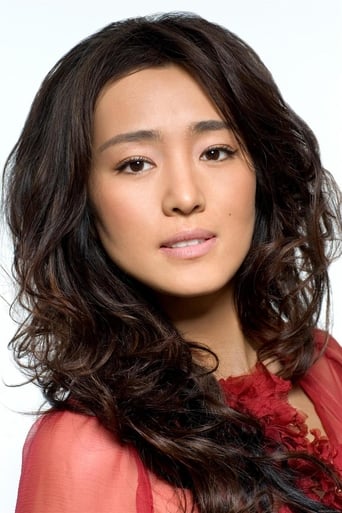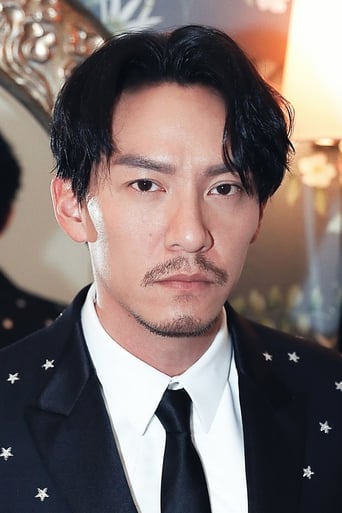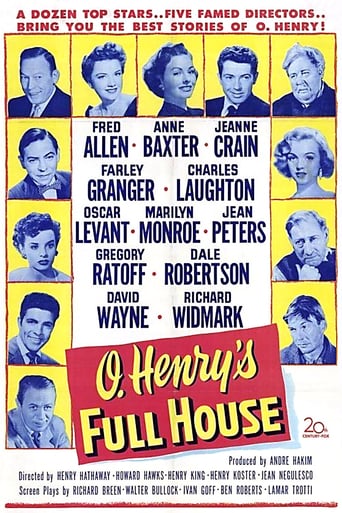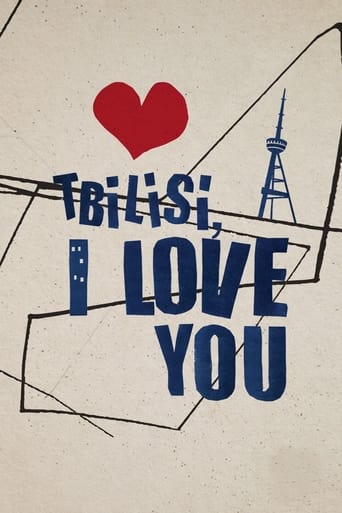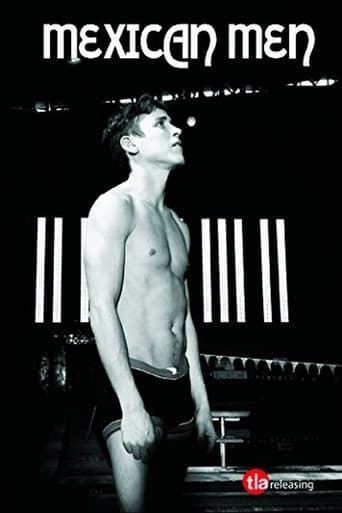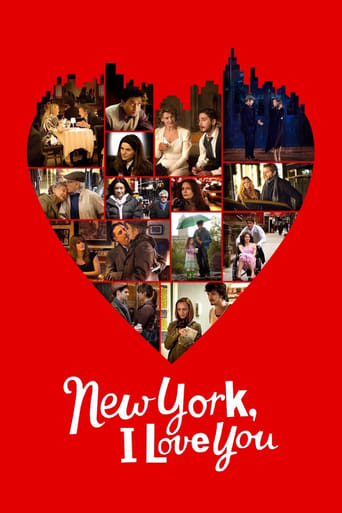Eros (2005)
A three-part anthology film about love and sexuality: a menage-a-trois between a couple and a young woman on the coast of Tuscany; an advertising executive under enormous pressure at work, who, during visits to his psychiatrist, is pulled to delve into the possible reasons why his stress seems to manifest itself in a recurring erotic dream; and a story of unrequited love about a beautiful, 1960s high-end call girl in an impossible affair with her young tailor.
Watch Trailer
Free Trial Channels
Cast


Similar titles
Reviews
Let's be realistic.
Fanciful, disturbing, and wildly original, it announces the arrival of a fresh, bold voice in American cinema.
This is one of the few movies I've ever seen where the whole audience broke into spontaneous, loud applause a third of the way in.
An old-fashioned movie made with new-fashioned finesse.
After reading a few negative reviews, I recently watched "Eros" and was pleased with the whole film. The three stories are the views that Michelangelo Antonioni, Steven Soderbergh and Wong Kar-Wai have of eroticism, and in two of them the segments are what one would expect of their creators, confirming the auteurist film theory. Antonioni's "Il filo pericoloso delle cose" --inspired by texts from his book, "Quel bowling nel Tevere"-- is vintage Antonioni. Of the three filmmakers, he is the only one who choose a contemporary story, probably to prove (at least to himself) that after 40 years of making his tetralogy of alienation, men and women are still literally wandering and talking but not communicating, again women find solidarity among themselves, and technology is as usual an obtrusive part in the landscape of human relationships. The erotic element in this story is the rawest and most elemental of the three segments, triggered by a sex-hungry male who is depressing to his wife, and a toy to an occasional sexual partner; while the style is perhaps the purest, or at least the one told with the greatest economy of resources: few shots, sparse dialogue, natural sets, and a very simple storyline. In contrast, Soderbergh's "Equilibrium" has as many camera set-ups as possible, different levels of narration, alternate monochromatic and color sections, two stars, and an oblique-oniric-videoclipistic approach to eroticism, that mostly relies on Psychology 101 criteria, a strategy that, I guess, is intended to be funny. I did not find it very funny, although watching Alan Arkin made me smile, as he made me remember his maniac performances in "The Russians Are Coming, The Russians Are Coming", "Catch-22" and "Last of the Red Hot Lovers". I wondered what the short was doing in this compilation film, but since that is how Soderbergh views eroticism, that I respect. The final section , Wong's "The Hand", based on the tale "The Twilight of the Bottom Dancer" (according to the director in an interview), illustrates the generalized (or maybe "cliched" would be a more appropriate adjective) notions of what the artistic approach to eroticism should be (for example, the tailor introducing his hand in a dress), but Wong and cinematographer Christopher Doyle are remarkable image-makers, and Gong Li and Chang Chen give very good performances, that I guess that for a modern moviegoer this must be the best segment. It is very good indeed, with soft transitions, measured rhythm, and good dramatic structure, covering a long lapse in a few minutes, but I see it as the fine conclusion of what Antonioni started and Soderbergh continued. A good film, perhaps better to be seen alone, with no interferences.
Reading the back of the DVD case - and even the summary on this site - would lead you to believe that this movie would be an exploration of love and sexuality by three well known world directors. You would think that it would be sensual, thought provoking, emotional, and given the title certainly erotic, and most of all, good. But sadly it wasn't any of these things.There were a few redeeming features - the first short was beautiful to watch and the actors were well chosen, the second had some bits of wonderful acting and interesting photography, and...um...for the third, only the location was interesting.In the end, don't believe the "plot summary" on this site, or the description on the DVD. Not only is it misleading, but some is just plain inaccurate. The only thing that delivered on its promise in this movie was the title screen that strung the movie together - which connected to the idea of what the movie SHOULD be, instead of what it actually was.As a last note, if you're still determined to watch this DVD, you may as well numb yourself further by watching the "Michaelangelo Eye to Eye" short in the Special Features. Antonionio (I think) wanders into a church in Italy and stares interminably at parts of statues created by the sculptor Michaelangelo; at least those are real art. Too bad the director didn't learn anything from his namesake...
What a treat! A film school in 104 minutes!Forget what the detractors say about this. Most seem to think that none of it is erotic enough and few "like" the Soderbergh and Antonioni projects.But you, dear viewer, you will know this as three explorations into how the eye creates the seductive impulse. And we have three masters, though I wish we also had Greenaway and Medem involved.I assume that these three did not collaborate in any way. I also assume that the sponsors did not specify that the projects be erotic, rather that they explore what it means to be erotically engaged.The first we see is by Kar-Wai Wong. His object of desire is Gong Li, who at 40 is still beautiful. She plays a prostitute who conspires to replace her old dressmaker with a young man. (The subtitles call him a tailor, to emphasize the tale that he spins.)She engages his desire-driven imagination, which binds him to her and brings out his very best in terms of the dresses he creates. She weaves him and through the clothes, he weaves her. Toward the end, the image is polished with her ill and out of favor, and he still as obsessed and caressing a dress he made, moving his entranced hand inside it. It is his hand the title denotes. At the very end, he tells a tale to his boss of his woman as back in the money, now fully his creation.The second entry is amazing. Soderbergh is often capable of creating plots with circular reference. And since the very beginning, this notion of one reality creating another has been at his center. But this outdoes even "Full Frontal."We have three dreams. One is the one we see first, a gauzy look through windows at an amazingly engaging scene: a beautiful redhead bathing and dressing. The dream starts as voyeurism through windows, but as is described later, our voyeur enters the dream as a participant. In the dream, he is on the bed dreaming.Shift to a psychiatrist's office, where we meet the dreamer, played by Downey, one of our few folded actors. He is a clock designer obsessed with this dream. Over time, he is enticed to lay down and segue from talking about the dream to actually enter the dream. During this time, the psychiatrist begins his own voyeurism out the window.Most reviewers saw this and thought the comic indifference was the point. Oh my. Their license to view films should be revoked.As Downey dreams, we enter the third world, the third dream. He pulls a trigger suggested in the earlier segment and wakes into the dream where he is now married to his desire, and he goes to clock-designer work where his assistant is the same guy as the analyst, except he is the one obviously insecure.All three worlds are set in the 50s. Which is the dream? Which is the source of pulling the desire into reality? Are dreams of desire cinematic or the other way around? Which of the paper airplanes connect?The third project is widely dismissed as the obsessive sexual impetulance of an old, fading man.The scene here is simple. A husband and wife have a spat. She is topless at first then puts on a transparent top as they go to a restaurant. There they briefly encounter another inhabitant of the beach resort where this is set. He visits this woman and they seduce each other, apparently a single event.Later, the husband and wife are reconciled. Both woman happen to be nude on the beach, both seemingly in a sensual plateau. They encounter each other; more precisely the wife encounters the other asleep, casts a shadow on her while she stirs. They stare at each other silently. Neither, incidentally, is particularly attractive.When the man and his affair begin, he has entered the "other" tower on the beach, after she wonders if he can stand her chaos, absolute chaos. Viewers seem to equate this with his famed trilogy about love from the sixties. Those were dumb films.How could they forget "Blowup," an essay on how cinematic memory bends or even defines reality. And how he stretched that into wonderful folded space in "Beyond the Clouds."You have to do some work here. You have to know that this is not about sex, or the erotic figure. Nor even anything at all having to do with examining a relationship. It is all about how perception defines the situation, moved erotically.Guess no one want to do the work. But if you are interested in film, you'll want to view these three notions of where the eye of love sits. With Wong, it is in the present, Soderbergh in the remembered and Antonioni the expected.I prefer Wong's world so far as experience. He even takes it as far as not having a script, but making up the movie as he shoots. Love should ideally be erotic, and the invention of that world should be one you coweave with your partner, dressing each other into the miracle.But these other fellows have hypnotic appeal as well.Ted's Evaluation -- 2 of 3: Has some interesting elements.
The initial concept for making this film was to offer three variations on the theme of love from three directors from three cultures. Or is the title 'Eros' more about the erotic than about love? Question unanswered by this triptych of minor works by some superb directors. The end result seems to be three streams of conscious thoughts looking for a reason to make it to the screen. With the brilliance of the three directors one would expect far more than the film delivers.Wong Kar Wai presents the strongest of the three films in a dark story about a tailor who sublimates his desire for a courtesan (Gong Li) by making clothes for her - a 'servant' who finally reverses his role. The photography and interweaving of the characters is very beautiful to experience.Steven Soderberg makes a testy little script about an ad man (Robert Downey, Jr) in therapy with a bizarre psychiatrist (Alan Arkin) exploring a recurring sensual dream. Shot is black and white the actors give it their all but the story is silly and becomes boring with all the distractions Soderberg works into the weak plot.Antonioni attempts to breathe life into the old Italian movies of lover's spats and diversions and comes up with what feels like a script-less little mess of a movie bent solely on see-through blouses and nude cavorting on beaches.As a triptych the film just doesn't become airborne, despite some very high powered, first rate directors. Much ado about very little. Grady Harp

